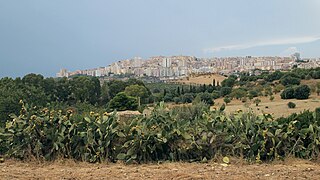
Agrigento is a city on the southern coast of Sicily, Italy and capital of the province of Agrigento. It was one of the leading cities of Magna Graecia during the golden age of Ancient Greece.

Harriet Ann Boyd Hawes was a pioneering American archaeologist, nurse, relief worker, and professor. She is best known as the discoverer and first director of Gournia, one of the first archaeological excavations to uncover a Minoan settlement and palace on the Aegean island of Crete. She was also the second person to have the honor of the Agnes Hoppin Memorial Fellowship bestowed upon her, and the very first female archeologist to speak at the Archaeological Institute of America.

The Sacred City of Caral-Supe, or simply Caral, is an archaeological site in Peru where the remains of the main city of the Caral civilization are found. It is located in Supe valley of Peryu, near the current town of Caral, 182 kilometers north of Lima, 23 km from the coast and 350 metres above sea level. It is attributed an antiquity of 5000 years and it is considered the oldest city in the Americas and one of the oldest in the world. No other site has been found with such a diversity of monumental buildings or different ceremonial and administrative functions in the Americas as early as Caral. It has been declared a Humanity Cultural Heritage site by UNESCO.

Gela is a city and comune (municipality) in the Autonomous Region of Sicily, Italy; in terms of area and population, it is the largest municipality on the southern coast of Sicily. Gela is part of the Province of Caltanissetta and is the only comune in Italy with a population and area that exceed those of the provincial capital.

Naucratis or Naukratis was a city and trading-post in ancient Egypt, located on the Canopic (western-most) branch of the Nile river, south-east of the Mediterranean sea and the city of Alexandria. Naucratis was the first and, for much of its early history, the only permanent Greek colony in Egypt, serving as a symbiotic nexus for the interchange of Greek and Egyptian art and culture.

Marina, also Marina El Alamein , ancient Leukaspis or Antiphrae, is an upscale resort town catering mainly to the Egyptian upper class. It is located on the northern coast of Egypt, with an 11 km (6.8 mi) long beach, about 300 km (190 mi) away from Cairo, in the El Alamein area.

Tharros was an ancient city and former bishopric on the west coast of Sardinia, Italy.
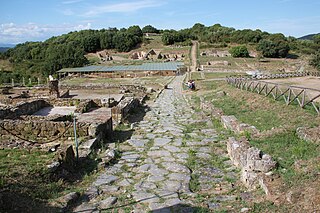
Rusellae was an important ancient town of Etruria, which survived until the Middle Ages before being abandoned. The impressive archaeological remains lie near the modern frazione or village of Roselle in the comune of Grosseto.
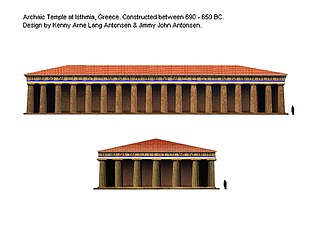
The Temple of Isthmia is an ancient Greek temple on the Isthmus of Corinth dedicated to the god Poseidon and built in the Archaic Period. It is about 16 kilometers (9.9 mi) east of ancient Corinth, at the site of ancient Isthmia. It appears to have been constructed in the seventh century BC though was later destroyed in 470 BC and rebuilt as the Temple of Poseidon at Isthmia in c. 440 BC during the Classical period.
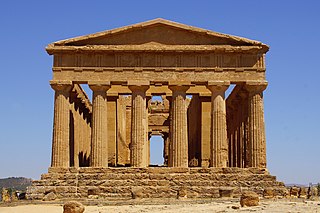
The Valle dei Templi, or Valley of the Temples, is an archaeological site in Agrigento, Sicily. It is one of the most outstanding examples of ancient Greek art and architecture, and is one of the main attractions of Sicily.

Akrai was a Greek colony founded in Sicily by the Syracusans in 663 BC. It was located near the modern Palazzolo Acreide.
Krimisa, Crimisa or Crimissa was a small ancient city in Magna Graecia, probably originating in the 7th century BC, situated in Calabria in the region of Punta Alice. It was inhabited by an indigenous people assimilated by the Greeks.

The Greek theatre of Syracuse lies on the south slopes of the Temenite hill, overlooking the modern city of Syracuse in southeastern Sicily, Italy. It was first built in the 5th century BC, rebuilt in the 3rd century BC and renovated again in the Roman period. Today, it is a part of the Unesco World Heritage Site of "Syracuse and the Rocky Necropolis of Pantalica".
Despite its abandoned state, it remains one of the most beautiful locations in the world, offering the most grandiose and picturesque spectacle that there is.
The Polizzello helmet is a Cretan production in bronze of the seventh century BC perfectly preserved. The cheeckpieces are engraved with the images of a warrior (Hoplite). It comes from the excavations of the archaeological site of Polizzello near Mussomeli in the Province of Caltanissetta.

The archaeological site of Polizzello or mountain of Polizzello was a site inhabited probably from the eleventh to the sixth century BC

Vassallaggi is a Sicilian prehistoric Bronze Age archaeological site, located on the hill of the same name, which had a later flourishing after the 7th century BC as a phrourion (fortress). The site is located in the middle of the Salso river valley, at 704 m above sea level, near San Cataldo in the province of Caltanissetta, in a strategic location for communication between the southern coast of Sicily and the northern part of the island. It has a NE-SW orientation and stretches along in parallel with the SS 122 San Cataldo-Serradifalco.
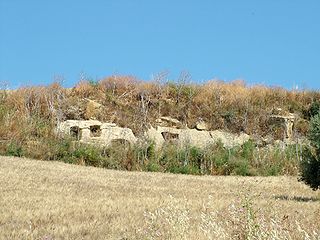
The archaeological park of Sabucina, located on the mountain of the same name near Caltanissetta, is an archaeological site in Sicily. The area contains settlements ranging from the Bronze Age to the Roman period.

The Greek Baths of Gela are ancient baths which were discovered in 1957, near the Ospizio di Mendicità on via Europa, Capo Soprano, which date to the Hellenistic period. Like the rest of the city, the baths were demolished in 282 BC after the conquest of the city by the Akragantine tyrant Phintias.
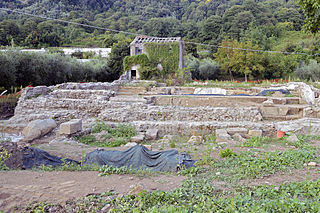
The Temple of Diana Nemorensis was an ancient Roman sanctuary erected around 300 BC and dedicated to the goddess Diana. The temple was situated on the northern shore of Lake Nemi, beneath the cliffs of the modern city of Nemi. It was a pilgrimage site on the Italian peninsula. The temple complex covered an area of 45,000 square meters.
San Leone is a seaside town and port South of Agrigento. It rises on the Akragas point, near the mouth of the Akragas river.






















